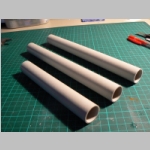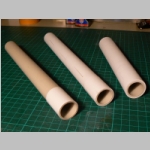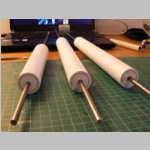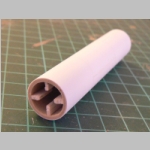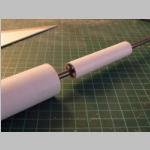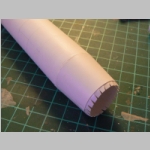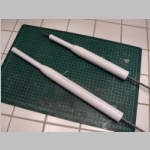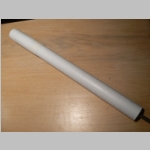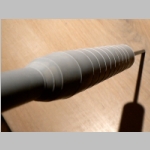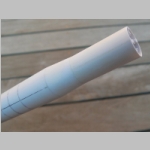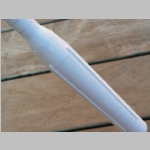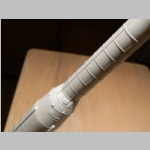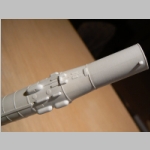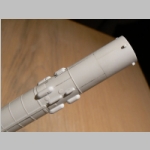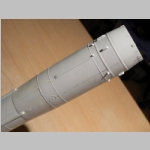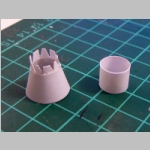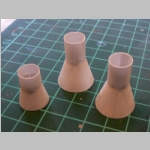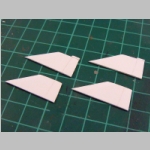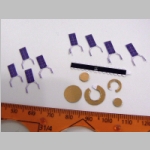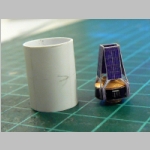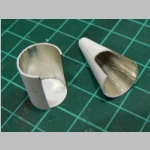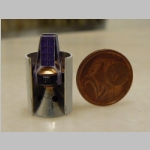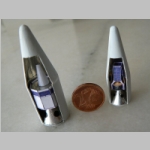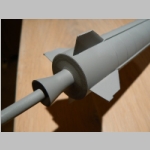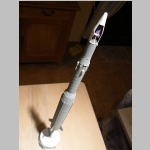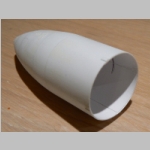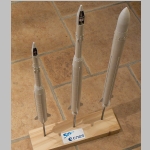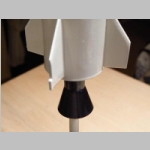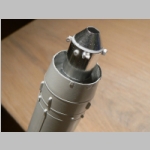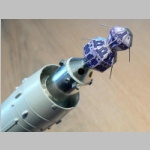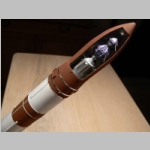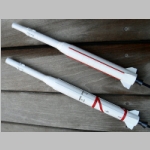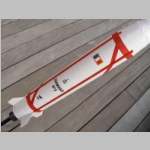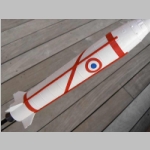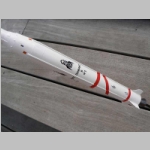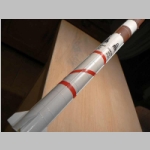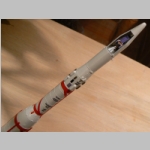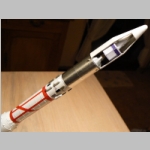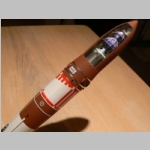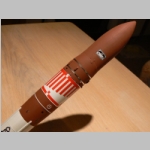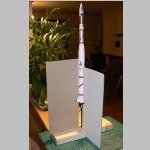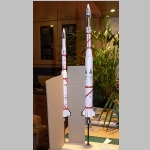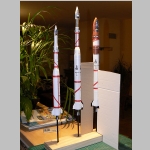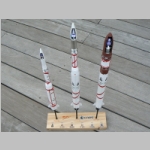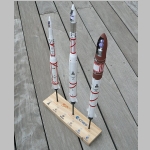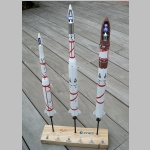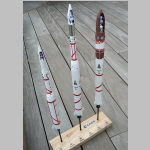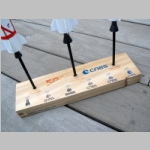MODELS OF THE FRENCH DIAMANT LAUNCHERS - Scale 1/48
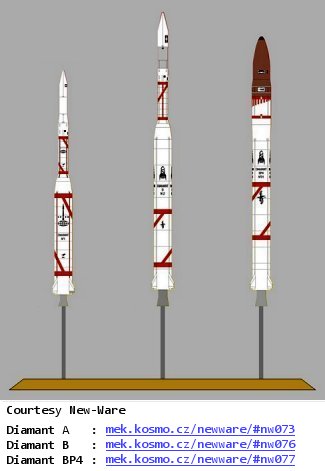 2011 will mark the fiftieth anniversary of the CNES French space agency (Centre National d'Etudes Spatiales). In the late fifties the cold war,
the Sputnik launch and the policy of independence of General de Gaulle implied for the government a high priority for space research. Research
bodies like the committee for space research (Comité de Recherches Spatiales - CRS) or the company for ballistic missile studies (Société
pour l'Etude et la Réalisation d'Engins Balistiques - SEREB) allowed technological advance on launchers. However a body was needed to
federate the efforts from different entities and allow France to enter the club of space power nations. CNES was then created on 19 December
1961.
2011 will mark the fiftieth anniversary of the CNES French space agency (Centre National d'Etudes Spatiales). In the late fifties the cold war,
the Sputnik launch and the policy of independence of General de Gaulle implied for the government a high priority for space research. Research
bodies like the committee for space research (Comité de Recherches Spatiales - CRS) or the company for ballistic missile studies (Société
pour l'Etude et la Réalisation d'Engins Balistiques - SEREB) allowed technological advance on launchers. However a body was needed to
federate the efforts from different entities and allow France to enter the club of space power nations. CNES was then created on 19 December
1961.
The objective to launch a satellite was fulfilled on 26 November 1965 with the launch from Hammaguir in Algeria of Diamant A carrying the
first French satellite nicknamed Asterix. 3 other Diamant A launches occurred from Hammaguir. The next more powerful Diamant B launcher
was launched from Kourou in French Guiana between 1970 and 1973. The program was be put to an end in 1975 with the most powerful
version Diamant BP4.
To commemorate this anniversary I decided to build these three French Launchers. The 1/48 scale was implicit to me as I already have several
launcher at that scale. It should be interesting to compare them and apprehend the progress made since the early sixties.
Construction of the stages
The first stage of the three launchers is very similar except for its length which is 9 m for Diamant A, 13 m for Diamant B and 13,3 m for
Diamant BP4. The diameter is the same, 1,40 m. To be sure to have a solid structure I used a 25 mm PVC tube (P1200386). I then glued
around several layers of 0.4 mm and 0.24 mm styrene until I had the proper 29,5 mm diameter corresponding to the 1/48 scale (P1200448).
The same technique was used for the second stage of Diamant BP4 using a greater number of styrene layers to achieve the larger 31,5 mm
diameter. For the second stage of Diamant A and the second and third stages of Diamant B, I used the same technique with a 15 mm PVC
tube.
Depending on the diameter of the stages a pierced styrene circle or styrene guides were inserted inside the tube. It allowed inserting a 6 mm
metal rod that will be used later on to support the model but also to perfectly align the different stages (P1200478 and following).
The junction between stages were made out of 0.24 mm styrene sheet, A second layer of styrene was put inside giving it the strength and allowing to better align the different cones as for Diamant A and
Diamant B (P1200492). The welds between the different sections of each stage are represented by fine 0.13 mm styrene strips (P1200519). The second stage of the Diamant BP4 (P1200518) and the
third stage of the Diamant A (P1200528) launchers were then made and details to the stages and the equipment case were added (P1200536 and following). 

The final details of the launchers concerned the first stage engines and the fins, as you can notice, the engine for Diamant A was much smaller then the ones for
Diamant B and BP4.
I then started construction of the fairings and satellites for all three launchers. The idea was to cut throught the fairings to show the satellites inside. At 1/48 the
satellites are very small (about 1 cm diameter for Diapason on Diamant A), the best method to build them was to use paper, I first printed the shape of the
satellites and then assembled them.
I wanted to represent the most interesting satellites of the Diamant programme, I then choose Diapason launched on Diamant A n°2 on 17 february 1966, Peole
launched on Diamant B n°2 on 12 december 1970 and Castor & Pollux launched on Diamant BP4 n°2 on 17 may 1975 (P1200633 and following).
Once the satellites were done I started then to work on the livery of the three launchers. For that purpose I made a blueprint extending the cylinders and cones and placing correctly the livery (see the pdf
file of the right). Once done this was translated into decals that I printed on inkjet decal paper. Application then started on the launchers. Note that for Diament A the conduits along the first stage of the
rocket were first painted red, they stayed white on the other launchers. (see P1200874 and following).
Once complete I glued the launchers on the wooden stand, one by one, making sure they were precisely vertical (P1200944 and following). The models were now finished, on the wooden stand I indicated
they were built for the 50th anniversary of the CNES French space agency (P1200981 and following) as well as the CNES logos since 1962 and the name of the satellites of each launcher.
Created by IrfanView
 2011 will mark the fiftieth anniversary of the CNES French space agency (Centre National d'Etudes Spatiales). In the late fifties the cold war,
the Sputnik launch and the policy of independence of General de Gaulle implied for the government a high priority for space research. Research
bodies like the committee for space research (Comité de Recherches Spatiales - CRS) or the company for ballistic missile studies (Société
pour l'Etude et la Réalisation d'Engins Balistiques - SEREB) allowed technological advance on launchers. However a body was needed to
federate the efforts from different entities and allow France to enter the club of space power nations. CNES was then created on 19 December
1961.
2011 will mark the fiftieth anniversary of the CNES French space agency (Centre National d'Etudes Spatiales). In the late fifties the cold war,
the Sputnik launch and the policy of independence of General de Gaulle implied for the government a high priority for space research. Research
bodies like the committee for space research (Comité de Recherches Spatiales - CRS) or the company for ballistic missile studies (Société
pour l'Etude et la Réalisation d'Engins Balistiques - SEREB) allowed technological advance on launchers. However a body was needed to
federate the efforts from different entities and allow France to enter the club of space power nations. CNES was then created on 19 December
1961.

